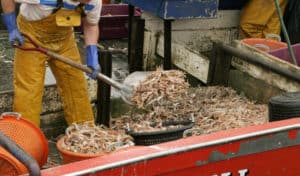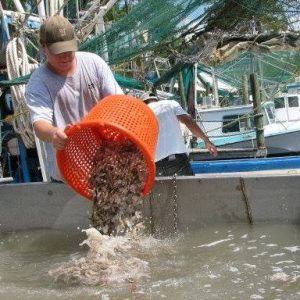Shrimp is a versatile and delicious seafood that is enjoyed by people all over the world. It is quick and easy to cook, making it the perfect option for busy weeknights or when you want to impress your guests.
Whether you are a seasoned cook or just starting out in the kitchen, this step-by-step guide will help you cook perfect shrimp every time.
Shrimp can be boiled, fried, baked, sauteed, grilled, and can even be eaten raw. Shrimp is one of the most versatile ingredients and almost every culture has delicious cooking methods and recipes for shrimp.
Read below to expand your horizons and learn tasty new and exciting ways to enjoy shrimp!
Step 1: Choose the Right Shrimp
The first step in cooking shrimp is choosing the right shrimp. When shopping for shrimp, look for large, plump, and firm shrimp that smell fresh and briny, with no strong odor.
If the shrimp are already peeled, make sure they are not slimy or discolored.
Check out our article on the 10 best tasting shrimp to see what shrimp you would like to use for your shrimp dish!

Step 2: Clean the Shrimp
Before cooking the shrimp, it is important to clean them properly. Start by removing the heads and tails.
If the shrimp are still in their shells, you will also need to remove the shells and devein them.
To devein a shrimp, make a shallow cut down the back and remove the vein with the tip of a paring knife or the back of a shrimp deveiner.

Step 3: Cook the Shrimp
There are several different ways to cook shrimp, including boiling, sauteéing, grilling, and baking.
Boiling:
To boil shrimp, fill a large pot with water and bring it to a rolling boil. Add the shrimp and cook for 1 to 3 minutes or until they are pink and cooked through.

*Pro Tip- Don’t add any seasoning or salt to the water while you’re boiling shrimp. Add your seasoning to the pot when the shrimp are done cooking. This will make your boiled shrimp peel easy.
Boiled shrimp is my favourite way to eat shrimp if you want to become a shrimp boiling master check out our complete guide to boiling shrimp.
Sautéing:
To sauté shrimp, heat a large skillet over medium-high heat and add a tablespoon of butter or oil. Add the shrimp and cook for 2 to 3 minutes on each side or until they are pink and cooked through.
Grilling:
To grill shrimp, thread them onto skewers and brush with olive oil. Grill for 2 to 3 minutes on each side or until they are pink and cooked through.
Baking:
To bake shrimp, preheat the oven to 400°F. Arrange the shrimp on a baking sheet and brush with olive oil. Bake for 8 to 10 minutes or until they are pink and cooked through.
Step 5: Serve the Shrimp
Serve the cooked shrimp with lemon wedges, garlic butter, cocktail sauce, or your favorite dipping sauce.
Friends Don’t Let Friends Eat Imported Shrimp!
Wild caught shrimp is a highly nutritious and delicious seafood option that has a variety of health and environmental benefits. Here are some reasons why you should consider incorporating wild caught shrimp into your diet.
Nutritional Value: Wild caught shrimp is an excellent source of lean protein, with a 3-ounce serving containing approximately 17 grams of protein.
This protein is essential for building and repairing muscle, as well as maintaining a healthy immune system.
Additionally, wild caught shrimp is rich in vitamins and minerals such as vitamins B12 and D, as well as iron and calcium.

Environmental Impact: Wild caught shrimp is a sustainable seafood option as it is harvested from natural populations and ecosystems.
Unlike farmed shrimp, wild caught shrimp is not associated with environmental degradation, such as mangrove deforestation and water pollution.
When purchasing wild caught shrimp, look for certification from organizations such as the Marine Stewardship Council to ensure that the shrimp you are eating was caught using environmentally responsible practices.
Health Benefits: In addition to being a great source of protein and essential vitamins and minerals, wild caught shrimp also has a number of other health benefits.
For example, the omega-3 fatty acids found in wild caught shrimp have been shown to have a positive impact on heart health, reducing the risk of heart disease and stroke.
Additionally, the high levels of selenium in wild caught shrimp have been linked to a reduced risk of certain types of cancer.
Versatility: Wild caught shrimp can be prepared in a variety of ways, making it a versatile ingredient in many different dishes.
Whether you prefer it grilled, boiled, sautéed, or baked, wild caught shrimp is easy to cook and goes well with a variety of flavors and ingredients.
Taste: Wild caught shrimp has a delicate, sweet flavor that is unmatched by farmed shrimp. This makes it a popular ingredient in many different cuisines, from Asian-inspired stir-fries to Creole-style gumbo.
Whether you are a seasoned cook or just starting out, wild caught shrimp is a delicious and healthy ingredient that is sure to become a staple in your kitchen.

In conclusion, wild caught shrimp is a nutritious and delicious seafood option that offers a number of health and environmental benefits.
If you are looking for a versatile and flavorful ingredient that is also good for you, wild caught shrimp is a great choice.
So next time you are grocery shopping or out at a restaurant, consider adding wild caught shrimp to your meal for a healthy and delicious seafood experience.
How to Reheat Shrimp
Reheating shrimp in the oven is a great option if you want to crisp up the exterior of the shrimp while keeping the interior tender and juicy.
Bake: To do this, simply place the shrimp on a baking sheet and bake in a preheated oven at 350°F for 5-7 minutes, or until the internal temperature reaches 145°F.
This method is particularly good for reheating fried shrimp or other breaded shrimp dishes.
Stovetop: Reheating shrimp on the stovetop is a good option if you want to warm up the shrimp quickly without having to wait for the oven to preheat.
To do this, simply heat a pan over medium heat and add the shrimp. Cook for a few minutes on each side, or until the internal temperature reaches 145°F. This method is good for reheating sautéed or grilled shrimp.
Microwave: Finally, reheating shrimp in the microwave is a good option if you want to quickly warm up a small portion of shrimp.
To do this, simply place the shrimp in a microwave-safe dish and microwave on high for 30-60 seconds, or until the internal temperature reaches 145°F.
This method is particularly good for reheating leftover shrimp from a takeout or restaurant meal.
In conclusion, reheating shrimp is possible and can be done in a variety of ways, including in the oven, on the stovetop, or in the microwave.
However, it is important to take the necessary precautions to ensure that the shrimp is reheated safely and reaches a safe internal temperature of 145°F.
Whether you are reheating leftovers or simply looking to enjoy a second helping of your favorite shrimp dish, with these tips, you can enjoy perfectly reheated shrimp every time.
Master your Craft
Cooking shrimp is a quick and easy way to add delicious and healthy seafood to your diet. Whether you prefer to boil, sauté, grill, or bake your shrimp, following this step-by-step guide will help you cook perfect shrimp every time.
With a little practice and creativity, you can create endless variations on this classic dish that are sure to impress your family and friends.
If you love shrimp as much as I do check out our awesome shrimp swag and help support Alabayou by “Keeping Tradition”

